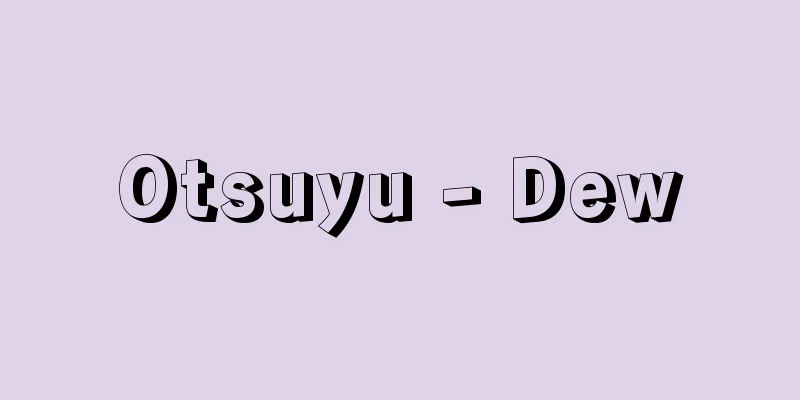Land survey - Kenchi

|
The determination of village boundaries (muragiri), surveying and confirming the classification of land within a village as rice paddies, fields, houses, etc., as well as its location, tanbetsu (area), rank (grade), and kokudaka (yield), and determining the village land area. This term has been used since the Sengoku period, and has been established as an official language since Toyotomi Hideyoshi's so-called Taiko land survey. Since kenzao (intermediate pole) and kennawa (intermediate rope) were used for land surveys, they were also called saoi-re (pole-entry), saoi-uchi (pole-attack), nawa-iri (rope-entry), and nawa-uchi (rope-attack). Land surveys were conducted by the Sengoku daimyo Imagawa, Odawara Hojo, Takeda, and Mori clans, as well as by Oda Nobunaga in the Kinai and Kinki regions, but the methods of land surveys, the indications of kokudaka, kan-taka, naigaka, and kari-taka, the units of area, and the size of the masu varied. In terms of form, land surveys were often conducted by making vassals write up the details of their territories. In the Taiko land survey, many of the surveys were conducted by direct inspection, and the standards and methods were not uniform at first, but they were gradually unified and were almost finalized around 1594. The main points were: (1) 6 shaku 3 sun = 1 ken, 300 bu = 1 tan, and quantitative units such as cho, tan, une, and bu were adopted; (2) land use was classified into three types, rice field, field, and house, and status was classified into three levels, upper, middle, and lower, with a separate lower level of land; (3) land production was assessed based on kokumori (yield per tan of field and field) in a Kyoto measure of 10 go = 1 sho, and this was displayed as kokudaka; and (4) village cutting was carried out. Land surveys were conducted for each plot of land, and one meishin (name-sennin) was appointed to be the owner of the land and pay the annual tax. The results of the land surveys were in principle compiled into a land survey book for each village, which became the basic ledger for understanding villages and farmers and collecting annual tax. The Edo Shogunate followed Hideyoshi's land survey method and carried out a nationwide land survey from the Keicho to Genna period (1596-1624). This was called the Shinken, while the Taiko land survey was called the Koken. The Shinken also piled up stones on the areas that had been excluded in the Koken, as well as on forests and wilderness, and shortened the length of one ken to six shaku, which led to an overall increase in rice yields and annual taxes. The increased yields were called deme-taka. Land surveys during the Edo period were under the jurisdiction of the Shogunate's Finance Magistrate, who, by order, would visit the site with his subordinates and survey the land with the guidance of village officials, and have the villagers inspect and confirm the Seinocho (Seinocho) (Seinocho), which was then used to create the land survey ledger. Land surveys were then conducted from the Kan'ei to Keian periods (1624-1652), and 27 articles of land survey rules (Keian Land Survey Articles) were issued in 1649. After that, there was the Kanbun (1661-1673) general land survey of the Kanto region, the Enpo (1673-1681) land survey of the shogunate territories in Kinai and nearby provinces, the Jōkyō (1684-1688) land survey of Kozuke and other areas, and the Genroku (1688-1704) land survey of Musashi, Shinano, Hida, and other areas, with each survey adding slightly new standards, and in 1726, 32 detailed articles on the survey of new land were issued. From this point on, surveys before the Kyoho era were called old surveys and those afterwards new surveys, and cultivated land surveyed before the Genroku era was called hon-dahata, and new land surveyed after the Genroku era but before the Kyoho era was called old new land, to distinguish them from new land surveyed after the Kyoho era. After land surveys were carried out in the Kanto provinces and Yamato region based on these land survey articles, the shogunate did not conduct any large-scale land surveys. However, small-scale land surveys were carried out in various places up until the end of the Edo period in order to incorporate new fields into main fields, crack down on hidden fields, and increase tax levies. → Related items Ina Tadatsugu|Iwami land survey|Okubo Nagayasu|Kurobane Domain|Hoe-shita tenancy|Inspection|Land survey pole|Land survey items|Inspection|Ishimori|Komoro Domain|Landholding|Local legends|Temple and shrine lands|New land development|Takato Domain|Tennoji|Name requester|Bakufu-han system|Higo uprising|Bizen land survey|Peasants|Hirano-go|Rice allocation|Masuda Nagamori|Village directory|Village detailed ledger Source : Heibonsha Encyclopedia About MyPedia Information |
|
村境を決定し(村切(むらぎり)),村内の土地について田・畑・屋敷などの別とその所在・反別(面積)・地位(ちぐらい)(等級)・石高(収穫量)を調査・確定し,村高を定めること。戦国期から用いられた言葉で,豊臣秀吉のいわゆる太閤検地以来公用語として定着した。検地には間竿(けんざお)・間縄(けんなわ)を用いることから,竿入(さおいれ)・竿打・縄入・縄打などともいわれた。戦国大名の今川・小田原北条・武田・毛利各氏,また,織田信長も畿内・近国などで実施しているが,検地の方法や石高・貫高・永高・刈高などの表示,面積の単位,枡の大きさなどはまちまち。また形態は,家臣に自分の所領の明細を書き上げさせる指出(さしだし)検地が多かった。太閤検地も当初指出検地が多く,基準や方法も同一ではなかったが,しだいに統一がはかられ,1594年ころにはほぼ確定された。その要点は,(1)6尺3寸を1間,300歩を1反とし,町・反・畝・歩などの定量単位を採用,(2)地目は田・畑・屋敷の3種,地位は上・中・下の3段階とし,別に下々地を設け,(3)10合=1升の京枡による石盛(こくもり)(田畑1反当りの収穫量)によって土地の生産高を査定,それを石高表示する,(4)村切を行う,の四つで,検地は土地1筆ごとに行われ,その土地の所持者であり年貢負担者となる名請人(名負人)1名が定められた。検地の結果は原則として1村ごとの検地帳にまとめられ,村・農民把握,年貢収取の基本台帳とされた。 江戸幕府は秀吉の検地方式をほぼ踏襲し,慶長から元和期(1596年−1624年)に全国規模の検地を実施した。これを新検といい,それに対して太閤検地を古検といった。新検では古検で除地とされた所や山林・原野まで石盛し,1間の長さを6尺に短縮したこともあって,全体として石高・年貢高増加の傾向を示した。増加した高は出目高といった。江戸時代の検地は幕府の勘定奉行が管轄し,その命により検地奉行が下役を連れて現地におもむき,村役人らの案内で検地し,清野帳(清帳)を村方へ閲覧させて確認させ(清野帳拝見証文の提出),それをもとに検地帳が作成された。次いで寛永から慶安期(1624年−1652年)にも実施され,1649年には検地掟27ヵ条(慶安検地条目)が出されている。その後,寛文(1661年−1673年)の関東総検地,延宝(1673年−1681年)の畿内・近国の幕府領検地,貞享(1684年−1688年)の上野(こうずけ)などの検地,元禄(1688年−1704年)の武蔵・信濃・飛騨などの検地があり,そのたびに新しい基準が若干ずつ加えられていき,1726年には詳細な新田検地条目32ヵ条が出された。これより享保以前の検地を古検,以後のそれを新検と称し,元禄以前に検地した耕地を本田畑,元禄以後享保以前に検地した新田を古新田といって,享保以後の新田と区別した。この検地条目による関東諸国と大和の検地が実施されて以後,幕府による大掛りな検地はなかったが,新田の本田への組み入れ,隠田(おんでん)の摘発,年貢増徴などのため,小規模な検地は幕末にいたるまで各地で実施された。 →関連項目伊奈忠次|石見検地|大久保長安|黒羽藩|鍬下年季|検見|検地竿|検地条目|検注|石盛|小諸藩|地押|地方凡例録|寺社領|新田開発|高遠藩|天王寺|名請人|幕藩体制|肥後一揆|備前検地|百姓|平野郷|分米|増田長盛|村鑑大概帳|村明細帳 出典 株式会社平凡社百科事典マイペディアについて 情報 |
>>: Investigative decision - Kendanzata
Recommend
Shezhou inkstone
〘Noun〙 An inkstone made from stone produced in Lon...
Nguyen Gia Thieu (English)
...A Vietnamese long poem written by Nguyen Gia T...
Caldenis - Caldenis
...a political movement with the masses as its su...
egg and dart
...The stories of geese or chickens that lay gold...
Ono Domain - Ohnohan
A Fudai domain with a 40,000 koku stipend based i...
Enantiomerism - enantiomerism
When stereoisomers are in a non-superimposable mir...
Artaxerxes III
King of the Achaemenid Persian Empire. Reigned 359...
Devotion - Kie
To devote oneself to and take refuge in something...
Subject
〘noun〙① The main subject. ② The central issue in s...
normal coordinate system
…In fact, the equations of motion after the trans...
Cytoplasmic polyhedrosis
A type of viral disease in insects. It mainly infe...
Azuma Kunitayu - Azuma Kunitayu
⇒ Tokiwazu Kanetayū (2nd generation) Source: Kodan...
Concert of Europe
A system of international dispute resolution throu...
Yong Chao
Year of death: Kaho 2.12.29 (1096.1.27) Year of bi...
Hara Martinho (English spelling)
One of the Tensho Embassies to Europe. His Portug...









